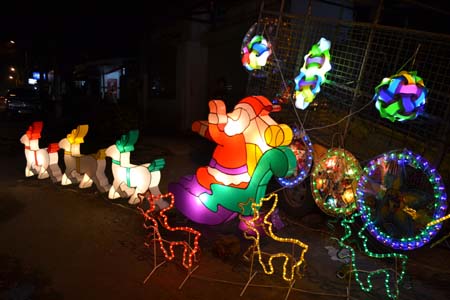
Highlights and Activities
Christmas parties
In urban areas like Metro Manila, many offices organise Christmas parties. These are usually held during the second week of December, or right before schools and universities go on holiday. Common activities include Monito/Monita (Kris Kringle), musical or theatrical performances and parlor games. Food is provided either through potluck, or via a pool of contributions to buy food. Some have fireworks displays.Simbang Gabi/Misa de Gallo
Simbang Gabi (Filipino, "Night Mass"; Spanish: Misa de Gallo, "Rooster's Mass") is a novena of dawn Masses from 16 December to Christmas Eve. The Simbang Gabi is practised mainly by Catholic and Aglipayans, with some Evangelical Christian and independent Protestant churches having adopted the practise of having pre-Christmas dawn services. Attending the Masses is meant to show devotion to God and heightened anticipation for Christ's birth, and folk belief holds that God grants the special wish of a devotee that hears all nine Masses.Morning observance of Simbang Gabi begins as early as 03:00 PST, while in some parishes, anticipated Masses begin the previous evening at 20:00 PST. After hearing Mass, Catholic families buy traditional Filipino holiday fare for breakfast outside the church and eat it either within the church precincts or at home. Vendors offer many native delicacies, including bibingka (rice flour and egg-based cake, cooked using coal burners above and under); putò bumbóng (a purple, sticky rice delicacy steamed in bamboo tubes, buttered then sprinkled with brown sugar and shredded dried coconut meat). Drinks include coffee, salabát (a ginger tisane) and tsokoláte (thick, Spanish-style hot chocolate). Some Aglipayan churches invite the congregation to partake of the "paínit" (literally, "heater"), a post-Mass snack of mostly rice pastries served with coffee or cocoa at the house of the Mass sponsor.

Christmas Eve
For Filipinos, Christmas Eve ("Bisperas ng Pasko") on 24 December is celebrated with the Midnight Mass, and the traditional Noche Buena feast. Family members dine together at around midnight on traditional yuletide fare, which includes: queso de bola (Spanish: "ball of cheese", which is edam cheese) sealed with red wax; tsokoláte, pasta, fruit salad, pandesal, relleno and hamón (Christmas ham). Some families would also open presents at this time.
Christmas Day
Christmas Day in The Philippines is primarily a family affair. The Misa de Aguinaldo is celebrated on December 25 and is usually attended by the whole family. It is the main means of celebrating Jesus Christ's birth for Catholics and Aglipayans.
The Misa de Aguinaldo is often celebrated between 10 pm and midnight, a schedule preferred by many Filipinos who stay up late on Christmas Eve for the night-long celebration of the Noche Buena.
Preferably in the morning, Filipinos typically visit members of the extended family, especially to pay respects to their elders. This custom of giving respect has been an age-old tradition in the Philippines called "Pagmamáno", which is done by bringing the elder's hand to one's forehead, while saying the phrase Máno Pô (lit. "Hand, please"). The elder then blesses the person who has given their respect, and in return gives "Aguinaldo", or money in the form of crisp, fresh-from-the-bank bills is given after the Pagmamano, mostly to younger children. Godparents are especially socially obligated to give presents or Aguinaldo to their godchildren.
A Christmas Lunch usually follows after the "Pagmamano". The menu is heavily dependent upon the finances of the family, with richer families preparing grand feasts, while poorer families choose to cook simple yet special dishes. Some families choose to open presents on this day after the lunch.
When nighttime falls, members of the family usually return home or linger to drink, or playing parlor games and Disco Party. Some may opt to have another feast for dinner. Some families spend the entire day at home to rest after the previous days' festivities.
from: Wikipedia
No comments:
Post a Comment